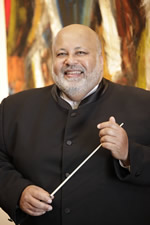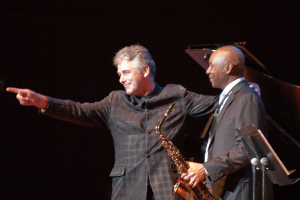For more than a week in advance, Dana Auditorium had been sold out for the much-anticipated July 17 return of pianist André Watts to the Eastern Music Festival. This also marked the return of NC Symphony Conductor Laureate Gerhardt Zimmermann to the podium of the all-faculty Eastern Philharmonic Orchestra. It is well known that Zimmermann is one of Watts’ favorite accompanists, and the pianist is a frequent soloist with the conductor’s orchestras. The concert’s start was delayed to allow latecomers to wade through the torrential downpour that swept the campus just before 8:00 p.m.
The concert ended with a stimulating performance of Beethoven’s Piano Concerto No. 4 in G, Op. 58, a personal favorite. Watts still has his chops – there were very few dropped or smudged notes. The fast runs were clearly articulated, and his timing of more ruminative passages was dramatically effective. His interpretation emphasized the Romantic elements without seriously violating the classical style. Zimmermann’s weaving of the orchestra’s strands fit the pianist’s conception like a glove. With the EMF orchestra’s large string section at his disposal, Zimmermann asked for and obtained a far richer string sound than I ever heard him get in Raleigh’s Meymandi Concert Hall, which seems to drain the bloom from low strings. Watts still seems to be having a rapid but usually silent conversation with the keyboard – his mouth is constantly in motion – and he still stomps with his left foot from time to time.
A real rarity, Tchaikovsky’s Seventh Symphony in E-flat, opened the concert. This was the EMF’s second performance of the work; I attended a student orchestra performance in 1987. The score is Semyon Bogatyrev’s orchestration of sketches Tchaikovsky made between 1891-1892 for three of four movements for a proposed symphony to be called Zhizn (Life). In stark contrast to the Fifth and Sixth Symphonies, the Seventh is optimistic and affirming. He had second thoughts, writing in December 16, 1892, that “(I) have gone over attentively… and looked with an impartial eye at my symphony…. The impression it produces is far from faltering; in a word, (it) was written just for the sake of writing something, and contains nothing interesting or appealing.” However, in 1893, he used the first movement sketch as a basis for the one-movement Third Piano Concerto, Op. 75. After the composer’s death, his pupil Taneyev freely adapted the remaining two sketches and published them as Andante and Finale, Op. 79. In 1956, Bogatyrev used the original sketches to orchestrate the symphony, replacing the missing scherzo with an orchestration of a piano piece from Op. 72. While it is pleasant enough listening, the themes are second- or third-drawer Tchaikovsky, repeated without sufficient variation. That said, the first and last movements have plenty of brilliant orchestral fireworks. The tranquil second movement is an appealing song without words, but only 81 of its 204 bars were found in Tchaikovsky’s hand. Bogatyrev had to make heavy use of the Taneyev transcription for piano as well as Tchaikovsky’s very rough manuscript draft. The ballet-like scherzo, a transplant from Op. 72, works surprisingly well, though it has no relation to the composer’s conception. Many long-time music lovers will find it hard to accept the complete absence of the dark melancholy that we have come to associate with the composer’s late works.
Reservations aside, Zimmermann and the orchestra gave it their all. The conductor made the most of the ample strings for both expression and balance. Strongly characterized woodwinds combined with glowing, precise brass for the broadest palette of color. Exposed solos for the viola and cello sections revealed their unanimity of tone and phrasing. Significant solos were performed by principal bassoonist Cedric Coleman, clarinetist Shannon Scott, flutist Les Roettges, and oboist Eric Olson, all of whom Zimmermann asked to stand at the end of the performance.
As if a posthumous Tchaikovsky symphony were not confusing enough, pianist Andréi Hotéev has used the text of the complete critical edition and the original manuscript in the Kline Museum to purge Taneyev’s excesses and reconstruct the Third Piano Concerto. This has been recorded on the Accord label. A fine 1962 recording of the Seventh Symphony performed by Eugene Ormandy and the Philadelphia Orchestra was fleetingly available on CBS Masterworks LPs and CDs. A Chandos recording of both works, with the London Philharmonic conducted by Neeme Jarvi, seems to still be in print.












